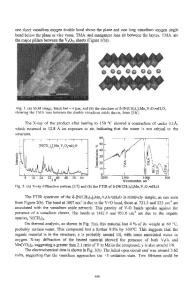Silver-Doped Vanadium Oxides as Host Materials for Lithium Intercalation
- PDF / 514,464 Bytes
- 6 Pages / 414.72 x 648 pts Page_size
- 58 Downloads / 326 Views
from 0.01 to 1. Except for the highest silver molar fraction (y=1), the doped hydrogels had a consistency similar to the original, undoped V20 5 hydrogel. AgV 20 5 showed a flocculated consistency instead of a gel. Thin film samples were prepared by spreading the silver-doped hydrogels onto stainless steel or glass plates. The surface coverage, i.e. the mass of material per unit area of the thin film samples, was varied from 0.02 to 30 mg/cm2 by changing the amount of coated hydrogel. Due to2 the flocculant consistency, AgV2O5 xerogel samples with a surface coverage below 0.3 mg/cm could not be prepared. All samples were first slowly dried in air overnight to prevent cracking and then dried under vacuum. Active material mass was determined by weighing the samples on a high precision balance (±+ltg). Film thickness measurements were made by using an Atomic Force Microscope from Topometrix as well as a mechanical profilometer (Dektak). The average density of the dip coated samples was 2.3 g/cm 3, determined by averaging thickness and weigh measurements over several samples.
Powders of composite, silver-doped vanadium pentoxide materials (Hex.AgyV 2O5 ), were prepared through a multistep procedure [9]. The first step consisted in the preparation of an organogel. It was prepared by exchanging the water from the hydrogel with acetone (Aldrich 99.5% used as received). A second solvent exchange with a low surface tension organic solvent (hexane) was then performed to produce the hexane organogel (hexanogel). Hexane needed in the latter step was from Aldrich(98.5% used as received). The double solvent exchange was necessary since water and hexane are not miscible and a single step preparation of the hexanogel was not possible at ambient conditions. The hexanogel still maintain the characteristic bicontinuous network typical of the parent hydrogel. If dried, the Hex.AgyV 20 5 powder has a surface area as high as 190 m2/g. The following step consisted of the preparation of the composite hexanogel. Selected amounts of Ketjen black (KJB, AKZO NOBEL) and polytetrafluoroethylene (PTFE, Du Pont) were added to the hexanogel in order to obtain the following ratio AgyV 2 O5:KJB:PTFE = 87%, 9% and 4% w/w. The mixture was stirred until a homogeneous suspension was obtained (10-15 hours). As a final step, the composite hexanogel was dried by evaporation of the solvent in dry air (R.H.
Data Loading...











